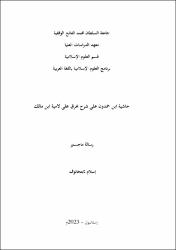حاشية ابن حمدون على شرح بحرق على لامية ابن مالك
Citation
SABATHANOV, İslam, حاشية ابن حمدون على شرح بحرق على لامية ابن مالك, Fatih Sultan Mehmet Vakıf Üniversitesi Lisansüstü Eğitim Enstitüsü Temel İslam Bilimleri Anabilim Dalı Temel İslam Bilimleri Arapça Programı, Yayımlanmamış Yüksek Lisans Tezi, İstanbul 2023.Abstract
تحمل هذه الدراسة عنوان "حاشية ابن حمدون على شرح بحرق على لامية ابن مالك، وهي موزعة على قسمين: الأول منهما تحدثت فيه عن ناظم اللامية: محمد بن عبد الله ابن مالك (ت. 672هـ)، وشارحها: محمد بن عمر الشهير بيحرق (ت 930هـ)، ومحشيها القاضي محمد الطالب بن حمدون ت (1273هـ)، ثم قمت بالتعريف باللامية والشرح الصغير، والحواشي عليه. ثم ختمت هذا القسم بالحديث عن حاشية ابن حمدون، فبينت اختلافات نسخها، وأهم مصادرها، وتعقبات المحشي على الناظم والشارح وعلى غيرهما من العلماء، وإضافات المحشي كالأجوبة عن الإيرادات والإشكالات وتحرير المسائل المستعصية والتنبيه على أوهام المخالفين والتقريرات الفقهية، والترجيحات، وختمته ببيان أهم النتائج التي توصلت إليها خلال الدراسة. أما القسم الثاني فخصصته لتحقيق الحاشية، وقدمت له بوصف النسخ المخطوطة، ثم منهج التحقيق وعملي فيه كتخريج الآيات والأحاديث، وعزو الأبيات مع بيان بحرها، والتعريف بالأعلام الواردة في الحاشية، والرموز والاختصارات.. ثم أتبعت ذلك بنص الحاشية مضبوطاً، ومفقرا، ومعنونا، ومنها ما فيه من أبيات، ومصحوبا بحواش فيها شرح الغريب وبيان المشكل منه، وعزو النقول إلى مصدرها، وفي أعلاه متن الشرح الصغير بخط أصغر من خط الحاشية. Bu araştırma "Hâşiyatü İbni Hamdün alâ Şarhi Bahrak alâ Lâmiyyeti İbni Mâlik başlığını taşımaktadır. İki kısma ayrılır: Birinci kısımda el-Lamiyye'yi derleyen kişiden bahsettim: Muhammed bin Abdullah İbni Malik ve onu şerh eden Bahrak ismiyle meşhur Muhammed bin Ömer ve ona haşiye yazan Kadı Muhammed bin Hamdun. Sonra Lamia'yı, küçük şerhi ve dipnotlarını tanıttım. Daha sonra İbn Hamdun'un haşiyesinden bahsederek, nüsha farklılıklarını, en önemli kaynaklarını, haşiyeyi derleyen ve şerh eden bu iki alim dışıdaki alimlerin tahkikatlarını, haşiyeye eklenen nakilleri, problemleri ve çözümü zor meseleleri, muhaliflerin yanılgılarını, fıkhi açıklamaları ve tercihleri açıkladım. Çalışma sırasında ulaştığım en önemli bulguları beyan ederek bölümü sonlandırdım.
İkinci bölüme gelince, onu haşiye incelemesine ayırdım ve yazma nüshaların bir tanıtımını sundum. sonra tahkik yöntemi, ayet ve hadis tahrici çalışması gibi, beyitleri ölçüleriyle inceleyerek haşiyede geçen işaretlerin, sembollerin ve kısaltmaların açıklamalarını yaptım. daha sonra haşiye metnini harekeli, paragraflı, başlıklı ve içindeki beyitlerle uyumlu şekilde, yabancı kelimeleri ve onunla ilgili problemleri dipnotlar eşliğinde açıklayıp, alıntıları kaynağına atfederek, üst kısımda haşiye hattından daha küçük bir hat ile metnin şerhini sundum. This study bears the title “Footnote of Bin Hamdoun on the explanation of Bahraq for the ibn Malik Lamiat.” (d. 672 AH), and its commentator: Muhammad bin Omar, the known also as Bahruq (d. 930 AH), and its commentator: Judge Muhammad al-Talib bin Hamdun (d. 1273 AH), then I introduced Lamyism and the small explanation, and footnotes to it. Then I concluded this section with talking about Ibn Hamdun’s footnote, so I showed the differences of its versions, its most important sources, the traced footnote for the author and the commentator and other scholars, and the additions to the footnote such as answers to questions and problems, editing intractable issues, alerting the delusions of violators, jurisprudential reports, and weightings, and concluded it with a statement of the most important results that i found during the study.
As for the second section, I devoted it to the investigation of the footnote, and I presented it with a description of the manuscript copies, then the investigation methodology and my work in it, I described the characteristics of the manuscript copies and explained the verses and hadiths mentioned in the gloss, as well as the couplets that the writer relied upon. I also provided descriptions of the symbols, marks, and abbreviations found in the gloss. Throughout the verses, I evaluated the conformity of Arabic diacritical marks and their placement. Additionally, I clarified the meanings of foreign words and explained the interpretations of ambiguous parts, and attributing it to it's sources. Moreover, I observed that the text of "Eş şerh ü sağir" was written in a smaller size above the gloss text, and I noted that the opinions in the gloss were based on references.



















